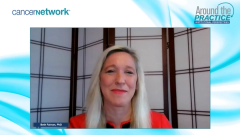
Clinical Practice Perspectives on Treatment of MM with Bispecifics
Before closing out their discussion on multiple myeloma management, panelists reflect on real-world clinical practice perspectives on treatment with bispecifics.
Episodes in this series

Transcript:
Beth Faiman, PhD, MSN, APN-BC: What did our case study take? We have so many options, like CAR [chimeric antigen receptor] T-cell therapy. She went on teclistamab. She was given the option of a clinical trial, and her family members were very supportive. We didn’t talk about how you need a caregiver support for transplant as well as the bispecific and CAR T-cell therapies. She had a great support system with family, friends, and religious affiliation. She was given teclistamab in combination with subcutaneous daratumumab and lenalidomide. We talked about long-term infections. It makes me a little nervous to give daratumumab with teclistamab, but she had a nice outcome in the beginning of the study. Does anybody want to share their thoughts on combination therapy with bispecifics? It’s going to be the wave of the future. We’ve got to find the right combination. Nothing is a 1 and done in myeloma, and very few patients will respond.
Sandra Mazzoni, MD: I can see these drugs being moved further up in therapy. I don’t think the answer is to use these on penta-refractory [patients]. That’s where we have the approval, but we’re moving them up and getting better responses. You’re going to see fewer infectious issues with these patients because their bone marrow is not so beat up.
Beth Faiman, PhD, MSN, APN-BC: Yes, for sure.
Louis Williams, MD: In this study, there was still a 20% to 30% infection rate, so it wasn’t without risk. What’s interesting is that there are some data that if you stop teclistamab after a couple of treatments…
Beth Faiman, PhD, MSN, APN-BC: They’re still responding.
Louis Williams, MD: It’s the same response so I could see using it in combination, dropping it at some point, and continuing on daratumumab plus or minus something else. But earlier is better.
Beth Faiman, PhD, MSN, APN-BC: What about the KarMMa study? We didn’t talk a lot about CAR T. We talked about teclistamab, and we talked about the concept, but what about the selection of ida-cel [idecabtagene vicleucel] vs cilta-cel [ciltacabtagene autoleucel]? Is that something you decide? Is it whatever slots are available based on the response rates? The response rates are a little better with cilta-cel [ciltacabtagene autoleucel] vs ida-cel [idecabtagene vicleucel]. CRS [cytokine release syndrome] might be higher in the cilta-cel [ciltacabtagene autoleucel] arm. We’re running out of time, but I’d like to hear your thoughts on CAR T selection.
Louis Williams, MD: I’m very hesitant to compare those 2 trials.
Beth Faiman, PhD, MSN, APN-BC: Cross-trial comparison.
Louis Williams, MD: The patient’s selection is a bit different in the trials. In general, the preponderance of data seem to suggest that responses may be a bit more durable, with similar response rates but higher durability with the cilta-cel [ciltacabtagene autoleucel] product. At this point, for most patients we’re considering—and you guys can back me up on this—we do what we can, and having access to a CAR T is probably favorable. Although with teclistamab, that may be changing, but right now, for younger, fit patients, I try to steer them toward Carvykti [ciltacabtagene autoleucel].
Jack Khouri, MD: I agree. The other thing is that real-world data recently published showed that 75% of the patients who got Abecma [idecabtagene vicleucel] would not have been clinical trial eligible. They still fared well; they had similar outcomes to the clinical trial. The stringent criteria that we follow in clinical trials are not as important.
Beth Faiman, PhD, MSN, APN-BC: Not representative of the population.
Jack Khouri, MD: I agree with Dr Williams. Cilta-cel [ciltacabtagene autoleucel] carries a little more toxicity, especially in terms of the delayed neurologic toxicity. I look at the patient’s neurological status too. If somebody has Parkinson disease, a history of seizures, or things like that, I tend to steer away from that.
Beth Faiman, PhD, MSN, APN-BC: Absolutely. We’ve had final thoughts on BCMA. Dr Mazzoni, do you want to close out this section with your final thoughts on CAR T and teclistamab?
Sandra Mazzoni, MD: The big thing for the future for all these BCMA-targeting agents is moving them all the way up to the point where they’re in the front line.
Beth Faiman, PhD, MSN, APN-BC: Front line? That’s controversial. We have smoldering trials, right?
Jack Khouri, MD: We do.
Louis Williams, MD: It’s T-cell fitness. You’re relying on those T cells. That’s why we see good results from allogenic CAR and stuff like that.
Jack Khouri, MD: Off-the-shelf CAR T-cells too.
Beth Faiman, PhD, MSN, APN-BC: This has been a great discussion. I enjoyed spending time with all of you. Thank you to our faculty for joining us in this lively discussion on the treatment of patients with multiple myeloma, brought to you by Cancer Network®. Thank you to our viewing audience. We hope you found this interactive discussion to be informative and beneficial to your clinical practice. Thank you.
Transcript edited for clarity.
Newsletter
Stay up to date on recent advances in the multidisciplinary approach to cancer.

















































































